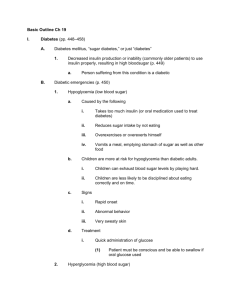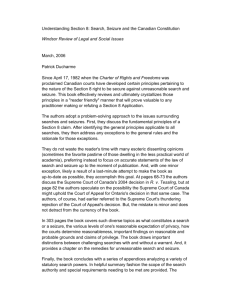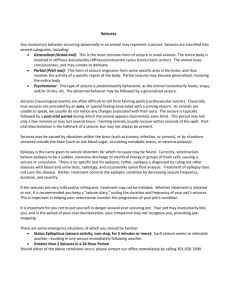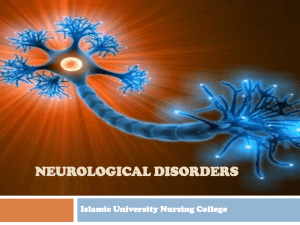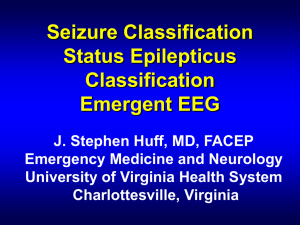Altered mental status Diabetic emergency
advertisement
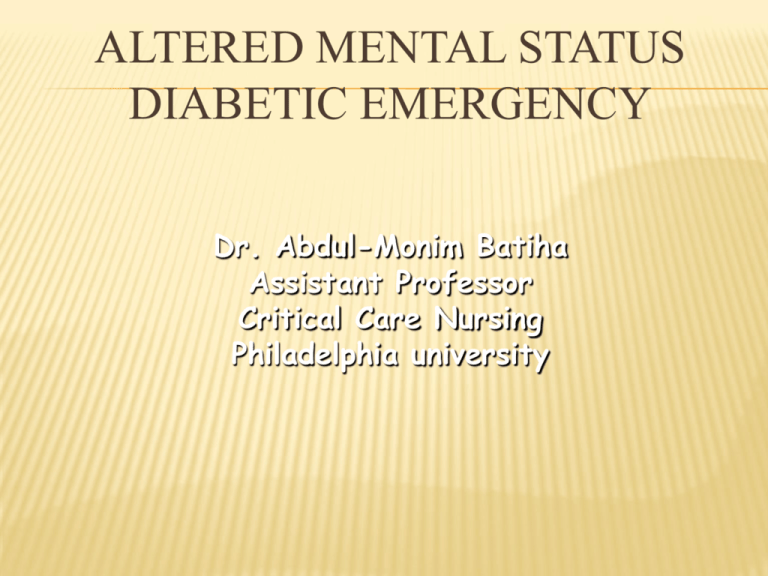
ALTERED MENTAL STATUS DIABETIC EMERGENCY Dr. Abdul-Monim Batiha Assistant Professor Critical Care Nursing Philadelphia university ALTERED MENTAL STATUS DIABETIC EMERGENCY DIABETES MELLITUS Diabetes mellitus is a metabolic disorder characterized by hyperglycemia and results from defective insulin production, secretion, or utilization. CLINICAL MANIFESTATIONS Onset is abrupt with type 1 and insidious with type 2. 1.Weight loss, fatigue 2.Polyuria, polydipsia, polyphagia CLINICAL MANIFESTATIONS EARLY 1.Polydipsia, polyuria 2.Fatigue, malaise, drowsiness 3.Anorexia, nausea, vomiting 4.Abdominal pains, muscle cramps 1.Kussmaul respiration (deep respirations) 2.Fruity, sweet breath 3.Hypotension, weak pulse 4.Stupor and coma COMPLICATIONS Acute • Hypoglycemia occurs as a result of an imbalance in food, activity, and insulin/oral antidiabetic agent. • Diabetic ketoacidosis (DKA) occurs primarily in type 1 diabetes during times of severe insulin deficiency or illness, producing severe hyperglycemia, ketonuria, dehydration, and acidosis. PREVENTING INJURY SECONDARY TO HYPOGLYCEMIA • Closely monitor blood glucose levels to detect hypoglycemia. • Instruct patient in the importance of accuracy in insulin preparation and meal timing to avoid hypoglycemia. • Assess patient for the signs and symptoms of hypoglycemia. o Adrenergic (early symptoms)”sweating, tremor, pallor, tachycardia, palpitations, nervousness from the release of adrenalin when blood glucose falls rapidly o Neurologic (later symptoms)”lightheadedness, headache, confusion, irritability, slurred speech, lack of coordination. • Treat hypoglycemia promptly with 15 to 20 g of fast-acting carbohydrates. o Half cup (4 oz) juice, 1 cup skim milk, three glucose tablets, four sugar cubes, five to six pieces of hard candy may be taken orally. o Nutrition bar specially designed for diabetics supplies glucose from sucrose, starch, and protein sources with some fat to delay gastric emptying and prolong effect; may prevent relapse. Used after hypoglycemia treated with fact-acting carbohydrate o Glucagon 1 mg (subcutaneously or I.M.) is given if the patient cannot ingest a sugar treatment. Family member or staff must administer injection. o I.V. bolus of 50 mL of 50% dextrose solution can be given if the patient fails to respond to glucagon within 15 minutes. • Encourage patient to carry a portable treatment for hypoglycemia at all times. • Assess patient for cognitive or physical impairments that may interfere with ability to accurately administer insulin. • Between-meal snacks as well as extra food taken before exercise should be encouraged to prevent hypoglycemia. • Encourage patients to wear an identification bracelet or card that may assist in prompt treatment in a hypoglycemic emergency. SEIZURE DISORDERS Seizures (also known as epileptic seizures and, if recurrent, epilepsy) are defined as a sudden alteration in normal brain activity that causes distinct changes in behavior and body function. Seizures are thought to result from disturbances in the cells of the brain that cause cells to give off abnormal, recurrent, uncontrolled electrical discharges. CLINICAL MANIFESTATIONS Manifestations are related to the area of the brain involved in the seizure activity and may range from single abnormal sensations, aberrant motor activity, altered consciousness or personality to loss of consciousness and convulsive movements. • Impaired consciousness • Disturbed muscle tone or movement • Disturbances of behavior, mood, sensation, or perception • Disturbances of autonomic functions NURSING INTERVENTIONS MAINTAINING CEREBRAL TISSUE PERFUSION • Maintain a patent airway until patient is fully awake after a seizure. • Provide oxygen during the seizure if color change occurs. • Stress the importance of taking medications regularly. • Monitor serum levels for therapeutic range of medications. • Monitor patient for toxic adverse effects of medications. • Monitor platelet and liver functions for toxicity due to medications. STATUS EPILEPTICUS (acute, prolonged, repetitive seizure activity) is a series of generalized seizures without return to consciousness between attacks. The term has been broadened to include continuous clinical and/or electrical seizures lasting at least 5 minutes, even without impairment of consciousness. Status epilepticus is considered a serious neurologic emergency. It has high mortality and morbidity (permanent brain damage, severe neurologic deficits). Factors that precipitate status epilepticus in patients with preexisting seizure disorder include medication withdrawal, fever, metabolic or environmental stresses, alcohol or drug withdrawal, and sleep deprivation. Preventing Injury • Provide a safe environment by padding side rails and removing clutter. • Place the bed in a low position. • Do not restrain the patient during a seizure. • Do not put anything in the patient's mouth during a seizure. • Place the patient on side during a seizure to prevent aspiration. • Protect the patient's head during a seizure. If seizure occurs while ambulating or from chair, cradle head or provide cushion/support for protection against head injury. • Stay with the patient who is ambulating or who is in a confused state during seizure. • Provide a helmet to the patient who falls during seizure. • Manage the patient in status epilepticus.





